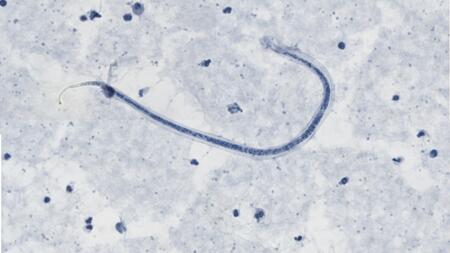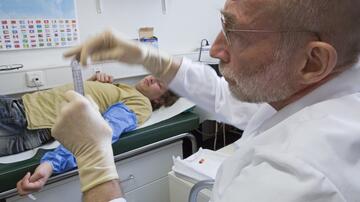A fascination for roundworms
Worms and other parasites cause numerous and widespread tropical diseases which are largely overlooked. At the DZIF, research teams are focused on fighting these diseases. Since August 2020, parasitologist Professor Marc Hübner has been developing this research further as a DZIF Professor for Translational Microbiology at the Bonn-Cologne partner site.
Professor Marc Hübner knows that worms are not one of the first things that come to mind in the field of microbiology. However, even when worms reach lengths of up to 70 cm, they are often still classified as microbes, along with other parasites. Parasitic helminths have fascinated Marc Hübner since the beginning of his studies. “I dedicated myself to the study of parasites right from the first semester,” he remembers. Hübner began his biology studies at the University of Hohenheim in 1998. At the time, as he was commuting and needed to fill in the time in-between courses, he swiftly registered for a parasite course that was not intended for first-semester students. This turned out to be his entry point into a field of study that still captivates him to this very day and in which he has been very successful.
Working between both the preclinical and clinical fields
In his Professorship for Translational Microbiology at the DZIF, he works between both the preclinical and clinical fields. His main aim is to test new agents against parasitic roundworms, or so-called filarial worms, in models and subsequently advance them for use in humans. Filarial worms cause severe diseases in the tropics which mainly affect the poorest people. Approximately 68 million people are infected with filarial worms which are transmitted by mosquito bites and can cause a syndrome known as elephantiasis (lymphatic filariasis). This condition is marked by the development of monstrous swelling of the extremities due to lymphatic obstruction. A further 21 million people are infected with filarial worms that cause onchocerciasis (river blindness) which can cause blindness and severe skin inflammation.
“These diseases are currently being combated by mass drug administrations but the drugs are only effective for a limited period of time,” explains Hübner. This is because the adult worms are not affected by the drugs and can keep producing new larvae known as microfilariae. Consequently, treatment must be carried out at least once a year over a period of several years, preventing the elimination of the diseases by 2020, as initially envisioned by the WHO. “Reaching this goal by 2030, does not look particularly promising either,” says Hübner. However, three promising agents that were identified in a collaboration effort are now in first clinical trials. In addition, next-generation compounds that target filarial and intestinal worms are being developed thanks to an important EU project known as HELP – Helminth Elimination Platform.
The interaction between worms and the immune system
This direct association to medicine gives Hübner an important incentive to work with parasites. His fascination from the start has been the interaction between worms and the immune system. Long before he started carrying out preclinical trials, he conducted research on immunomodulation caused by filarial worms. His first association with this topic came about following an excursion to Brazil during his studies after which all the students returned home with malaria. This is how Marc Hübner became acquainted with the Institute for Tropical Medicine in Tübingen, where he later conducted research on single-cell parasites known as cryptosporidiae for his diploma thesis. His subsequent dissertation focused on immunomodulation caused by filarial worms, which shaped the research he was to carry out in future.
“The impressive thing about these parasites is that they are able to suppress the human immune system in such a way that the person infected often does not develop any symptoms therefore allowing the worm to happily survive.” Hübner explains. He describes a fascinating example: following an infection with the Loa loa roundworm, the offspring, or so-called microfilariae, can be present in huge numbers in human blood. A millilitre of blood can contain over 30,000 of these microfilariae which are quarter of a millimetre long. “And the person looks perfectly healthy because the worms influence the immune system in such a way that it suits both the host and the parasite.” When this immunomodulation by filarial worms is unsuccessful, people develop severe symptoms of filariasis. The biologist is also engaged in the study of his second fascination: the immunomodulation caused by worms and their effect on different diseases. The influence of worm infections on autoimmune diseases and metabolic diseases such as adult-onset diabetes and sepsis is a research field that keeps producing exciting new results. With regard to the coronavirus, it is currently assumed that worm infections in Africa are helping to prevent more severe courses of the disease from developing.
There was no stopping Marc Hübner in 2006 when he was offered a post-doc position in Washington D.C. which focused on roundworms. The prospect of being able to carry out further research on filarial worms and investigate their interactions with autoimmune diabetes was a compelling opportunity for him. He moved with his entire family - his wife and two sons who were born before his studies. Four intensive years of research followed, as did a life that is difficult to compare with life in Germany. “The recreational appeal was simply superb. Three hours away from the ocean, the children were settled in very well and we had many friends.” In addition to this, he was able to fully dedicate himself to work on his research themes. “The NIH (National Institutes of Health) were conveniently located right across the street and being able to work with the immunologists there was an incredible opportunity,” the biologist remembers.
From Washington D.C. to Bonn
In 2010, the family had to say goodbye and move from Washington D.C. to Bonn. It was not easy, he readily admits and his sons, aged six and nine at the time, were certainly not enthusiastic about it. However, the state of the healthcare system in the USA with parents living in Germany and the ages of the children made it necessary to take this step. “And I knew I wanted to go to Bonn, where Prof. Achim Hörauf, an expert in parasitology, was conducting research on filarial worms.” Being able to set up his own working group and continue with research into filarial worms was enough incentive for Marc Hübner to move to Bonn. “The children also handled the change well, although they did complain about school starting earlier in the morning,” he says with a chuckle.
From 2014, preclinical research work took up more of Marc Hübner’s time, which predestined him for DZIF professorship. He currently supports the DZIF flagship project “Corallopyronin A as a drug candidate for adult worms” and the compound is currently being prepared for a phase I clinical trial. “However, the trial is not due to start before 2023,” Hübner estimates, as toxicity studies, which are a prerequisite for conducting the trial, are still ongoing. Alongside this, the researchers in Bonn are conducting studies in Sub-Saharan Africa, which are, however, currently at a standstill. “We are currently unable to work on the ground because of the new coronavirus.” Like everyone, Marc Hübner is yearning for the pandemic to end. By no means does he want to miss out on travel to carry out his research in the future.
After speaking for an hour in front of the computer screen, it would have been tempting to get a glimpse of his laboratory and admire the worms, but currently this is not an option in times of corona. Luckily Marc Hübner has just recently started his work at the DZIF so he will hopefully still be there for a long time to come.






